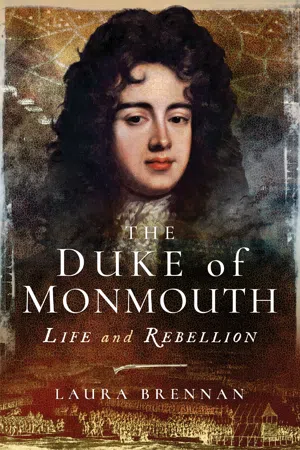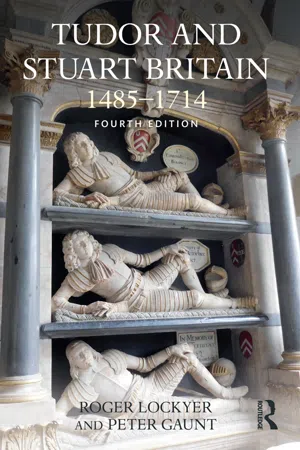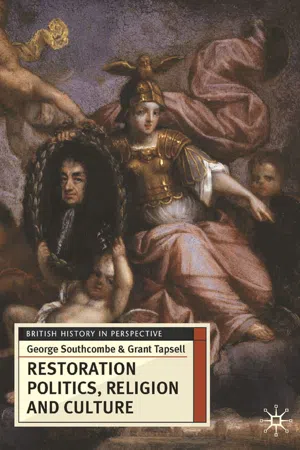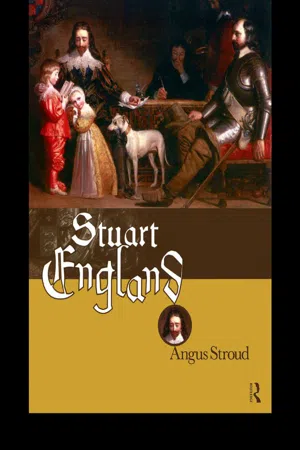Charles II
Charles II was the King of England, Scotland, and Ireland from 1660 to 1685. He is known for his restoration to the throne after the English Civil War and the rule of Oliver Cromwell. Charles II's reign was marked by the restoration of the monarchy, the rebuilding of London after the Great Fire, and the expansion of the British Empire.
6 Key excerpts on "Charles II"
- eBook - ePub
The Duke of Monmouth
Life and Rebellion
- Laura Brennan(Author)
- 2018(Publication Date)
- Pen & Sword History(Publisher)
...Chapter 2 Charles II: A Life in Exile and the Birth of a Son To put Monmouth’s life into context, it is important to briefly explore what life was like for Charles II in exile while England was in the Interregnum, under the control of the Lord Protectorate, Oliver Cromwell and his victorious members of parliament. The first aspect to note is that the initial part of Charles’ time in exile was spent fighting to regain his throne. His court in exile was far from united; instead, it was divided by politics and was a viper’s nest of scheming, something his court would continue to do after his restoration. Charles II’s reign, therefore, started as it was to continue; full of plots, political wrestling and conflict. Charles did attempt to look to other European counties in order to help him get back the throne. In order to succeed in this so soon after the execution of his father, Charles’ best political and strategic chance of successfully re-obtaining the crown was to take the Scottish throne of his ancestral royal house, the Stuarts. There is evidence that an alliance with Charles (then still the Prince of Wales) and Scotland was being conceived as early as 1648: Murray’s information from Scotland that their governing party there would raise an army of 20,000 men to support the Prince … to answer letters from the Committee and Assembly with gentleness; to take the Covenant if pressed to do so and to send Mr Denham to Scotland. 2 In 1649, Charles II was conditionally declared King of Scotland on the proviso that he would agree to the terms and agreements laid down by the Covenanters. The Scots wanted their General Assembly to be recognised within England, for Presbyterianism to become the national religion of the whole country and for Charles to take the Solemn League and Covenant Oath. Even though Charles was unhappy with these terms, he was prepared to compromise as in the circumstances, it was the best course of action available to defeat Cromwell...
- eBook - ePub
Tudor and Stuart Britain
1485-1714
- Roger Lockyer, Peter Gaunt(Authors)
- 2018(Publication Date)
- Routledge(Publisher)
...Chapter 18 Charles II The Restoration and Charles II in perspective The legacies of the mid-seventeenth century and the depth and durability of the changes wrought during the 1640s and 1650s are not entirely clear and give rise to continuing historical debate. The traditional view suggests that there had been a demonstrable change in political and constitutional power away from the Crown and towards Parliament and that although the return of Stuart kingship in 1660 led to the reversal of some of the specific statutes and means by which this had been achieved, the overall shift in power nonetheless survived to shape a very different type of post-Restoration monarchy. Similarly, traditional accounts argue that, while the Church of England also returned in 1660 and in many ways appeared to be the same as the pre-war Church, in reality things had altered – the Restoration Church lacked the authority and hold over the whole English (and Welsh) population that the Church had possessed during much of the Elizabethan and early Stuart period and, moreover, after 1660 religion became less central to the lives of many people and religious intensity and passions began to recede in public life, it is argued. These views were challenged in the late twentieth century by historians who tended to see in these areas greater continuity between the pre-war and the post-Restoration eras and to argue that the Restoration Crown and Church exercised much the same powers and held much the same positions as their early Stuart predecessors and also that religion and the role of the state Church remained throughout the Restoration era a central, vital and passionate element of everyday life as well as of government and politics...
- eBook - ePub
Restoration Politics, Religion and Culture
Britain and Ireland, 1660-1714
- George Southcombe, Grant Tapsell(Authors)
- 2009(Publication Date)
- Bloomsbury Academic(Publisher)
...Chapter 4: Was Charles II a Successful ‘Royal Politician’? To play the king was an exceptionally demanding role in early modern Europe. The difficulty sprang from the pressure of satisfying three distinct audiences: a monarch’s own subjects; his royal peers in other states; and posterity. This was the harsh reality facing any king but the scale of the challenges facing Charles II was unusually high. For all the initial jubilation surrounding the Restoration the task of maintaining the regard of a people deeply divided by 20 years of chronic political crisis, bloody civil war, and bewildering constitutional changes would have taxed even the most brilliant ruler. Once a thousand years of monarchy had been temporarily eclipsed by a republic could its appearance of timeless invulnerability ever be rebuilt? As the Anglican cleric John Glanvill opined in 1667 with the aid of a homespun analogy: Though government may be fixed again upon its foundations and laws turned into their ancient channel after the violence they have suffered, yet they lose much of their reverence and strength by such disestablishment. And the people that have rebelled once and successfully will be ready to do so often. As water that hath been boiled will boil again the sooner. 1 The situation abroad was scarcely less problematic. There the geo-political reality was that after more than a century of intense conflict between the Habsburg rulers of the Spanish kingdoms and the Valois and Bourbon kings of France, the latter was emerging as the hegemonic European power under the personal rule of Louis XIV from 1661. The Stuarts could no longer act – or pretend to act – as the balancing force between two competing powers: they would have to choose between moving within the orbit of a more powerful France or lending weight to some kind of coalition of lesser princes attempting to rein in French power and ambition. Yet arguably posterity was the toughest audience of all...
- eBook - ePub
Early Modern England 1485-1714
A Narrative History
- Robert Bucholz, Newton Key(Authors)
- 2019(Publication Date)
- Wiley-Blackwell(Publisher)
...This, too, would have profound consequences. Problems of Sovereignty, Finance, Religion, and Foreign Policy, 1660–70 In the meantime, it should be obvious that the king's personality hardly fit him to deal with the great issues left over from his predecessors' reigns. Take sovereignty. Despite the Restoration compromise between those who favored unqualified royal sovereignty and those who favored Parliament's claims to partnership (if not supremacy), Charles II proved to be every inch a Stuart, no more ready to share power with or accommodate his policies to Parliament than his father or grandfather had been. For example, when, in 1678, he was urged to explain the rationale of his byzantine foreign policy to Parliament, he replied, incredulously, “Then they'll be able to see all that has been done and what we are doing.” 6 Worse, he had spent much of his exile on the continent, in the shadow of his absolutist cousin, the Sun King, Louis XIV (1638–1715; reigned 1643–1715). 7 The French king, who did not have to get his policies approved or funded by a parliament, was in the 1660s fast becoming the most powerful and successful monarch in Europe, and, therefore, something of a role model for Charles II. As this implies, France was replacing Spain as the continent's greatest military power and most feared nation. As we shall see, this came to alarm contemporary English men and women, not least when the Catholic Louis began to cast his eye on the vast Spanish Empire. But Charles II could not help but envy it all, and many suspected he would seek to emulate it. Those fears may have been exaggerated; “absolute rule” was more of an occasional pipedream for Charles II than a constant goal. He had neither the resources, nor the personal determination, capacity for hard work, or sheer ruthlessness to achieve the control that Louis XIV possessed. Nor did he have a first minister who might have supplied the necessary toughness to manage Parliament for him...
- eBook - ePub
- Angus Stroud(Author)
- 2002(Publication Date)
- Routledge(Publisher)
...…There is much truth in this…yet qualifica-tions are needed. …It may be doubted if Charles II felt much like a victor in September 1662. …He had become the first English monarch since the Middle Ages to be successfully defied by his leading churchmen. …His direct power over the community was truncated [limited] by the permanent abolition of the prerogative courts, and his ability to wage war…depended upon the goodwill of Parliaments. … An ironic case could be made for the Restoration Settlement as a confirmation of the victory of John Pym and the original parliamentarian party. Most of the reforms of 1640–1 had been confirmed, and England now had a King who ruled as Pym’s set had wished. …Above all, the monarch was still bound by the Triennial Act to summon regular Parliaments. (Ronald Hutton, The Restoration, 1658–1667, 1985) The Convention was dissolved late in December 1660. Its members departed thinking they had achieved a framework for a settlement. Much had been done which gave them confidence: with Charles II, were restored the institution of monarchy, two Houses of Parliament, the Church of England, much of the country’s legal system, and its traditional ruling élite of greater gentry and richer merchants. …It was doubtful though if it would prove a lasting settlement. Impossibly high expectations (of the Savoy Conference, for instance), too many critical unanswered questions (the executive-legislative balance of power), too many decisions based on faulty information (Charles’ income for example) —all pointed to an unstable future...
- eBook - ePub
Consolidating Conquest
Ireland 1603-1727
- Padraig Lenihan(Author)
- 2014(Publication Date)
- Routledge(Publisher)
...CHAPTER 8 Charles II 1660-85 Restoration Only Oliver Cromwell's formidable personality and the menace of his army held the Protectorate together because his regime did not enjoy the support of the gentry in England, or still less, Scotland or Ireland. 1 As the Old Protestants had been mostly royalists who switched to the winning side quite late, they were regarded with suspicion, excluded from political life and threatened with composition fines as a condition of keeping their estates. 2 Henry Cromwell repudiated Fleetwood's alliance with the Baptists and Independents and tried to broaden the regime's base by, among other things, quietly dropping composition fines to attract Old Protestant support. 3 Simultaneously, Broghill, the Protector's man in Scotland, tried to draw more locals there into cooperation with the regime. 4 This policy of co-option and compromise moved from the fringes to the heart of the realm in February 1657 when Broghill led a majority of the Commons in proposing to reinvest authority in a king, parliament and a national church bound by common doctrine. The 'Humble Petition and Advice' proffered by Broghill and Henry Cromwell begged Oliver Cromwell to declare himself that king. While he took on some of the style and forms of monarchy, Cromwell reluctantly turned down the crown, fearing the hostility of the army generals. ‘The man who destroyed the Protectorate was Oliver Cromwell.’ 5 He bequeathed near-bankruptcy and made no arrangements for a successor other than to nominate his son Richard on his deathbed in September 1658. 6 The army and the politicians failed to work out a working compromise in the third Protectorate parliament summoned in January 1659...





